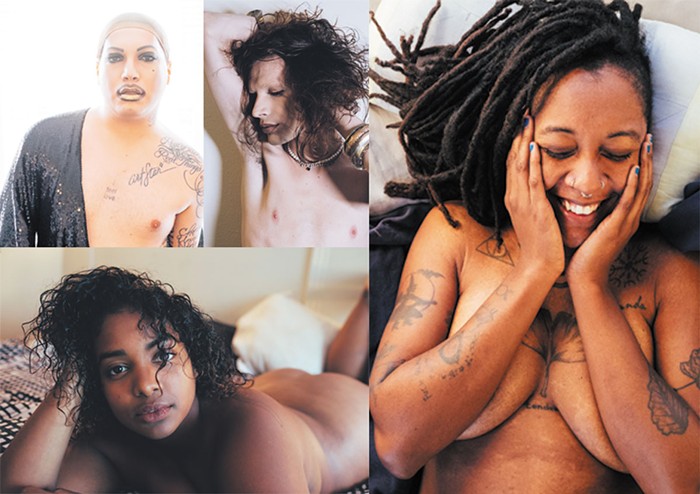Right now, the walls of Vermillion are covered with photographs of bodies. Fat bodies and thin bodies. Brown bodies and white bodies. Bodies with tattoos and bodies with scars. Gender nonconforming bodies. Each one revealing a private, interior world of vulnerability and emotion typically reserved for our most intimate moments.
The bodies are part of Queer Feelings, an ongoing exploration by photographer Adrien Leavitt of queerness and the intimate, complex relationship that we have with our bodies. "As a trans person and a queer person, I often feel like I don't see representations of myself in media or art," Leavitt tells me. "When I finally found representations of queer and trans people that I could relate to—that looked like me or like my community—I felt tremendously moved. With that in mind, I started exploring self-portraiture as a way of reflecting on myself and my own identity, particularly as it relates to gender."
Eventually, the self-taught photographer (who also works as an attorney for the King County Department of Public Defense) began turning his camera on other individuals who self-identify as queer—both friends and new acquaintances who have found him through open calls for models. The resulting portraits have a directness reminiscent of Catherine Opie or Zanele Muholi, but with a very sensual emphasis on warmth and tenderness. Leavitt's subjects often fill the entire frame, cropped in a way that conveys familiarity and closeness.
"The experience of photographing someone I know well is obviously different than someone who I've just met, but it amazes me how open people are to the experience and what a special connection we're able to form while we take the photographs," he tells me. That connection, fostered by Leavitt's gentle charisma, seems to be the key to capturing these moments. Standing in front of these portraits almost makes you feel like you're in bed with some of these people—in a fun, exploratory sense that feels comfortable, not objectifying. And a lot of them are smiling—genuine smiles that you can tell are captured and not posed.
Now three years into the project, Leavitt has photographed more than 50 individuals for Queer Feelings. As the images have evolved, so has the project statement Leavitt shares with everyone he photographs. Unlike many photographer-model agreements, where a model gives up all rights to how their image is used in the future, participants may decide to opt out of Queer Feelings at any time, resulting in the removal of their images from Leavitt's website and public exhibitions. This ongoing negotiation of consent further heightens the intimacy and trust the artist has with his subjects, allowing people a safe, comfortable context for opening up.
For Leavitt, this is a very important part of the work. "Having a portrait taken, particularly a nude portrait, is a very vulnerable process for the person being photographed. That vulnerability allows a different level of visibility—a very intimate visibility. For me, queerness is about all of that. It's about being vulnerable in a world that often rejects us or asks us to be palatable under a system that values certain types of bodies and identities, particularly white bodies, thin bodies, and gender conforming bodies."
Queer Feelings exists as a book and a website, but the experience of seeing the photos installed in a gallery provides an opportunity to encounter the figures on a human scale. "At the opening at Vermillion, I talked to so many people about their experience viewing the work in a physical space (rather than on the internet) and how it affects their sense of self," says Leavitt.
Encountering these images of bodies in a space with other bodies creates an awareness of their impact, but the book and website allow the project to reach a wider audience. "I received a note from a mom who bought the book for her queer teenager who is exploring their own gender," he smiles. "I've sent a few books overseas, too. Disseminating this body of work feels very powerful!"
In a capitalist, heteropatriarchal society, "power" is often associated with dominance, but power can also be negotiated through vulnerability, openness, and trust. Leavitt's images are powerful in the latter, queerer sense.
"I wanted to make a body of work that allowed us to see ourselves and truly bask in our beauty," says Leavitt. "For me, the experience of being seen is critical to creating a sense of self, value, power, and community."
"I hope that by creating work that actually shows queer people in an intimate way, we have the opportunity to more fully see ourselves." ![]()


















